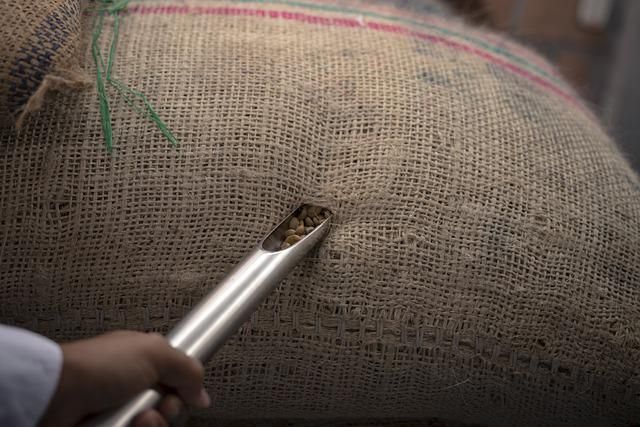
The coffee tree
The coffee tree grows in subtropical climates, has dark green glossy leaves and is covered in white flowers when in bloom. The scent of these flowers is reminiscent of jasmine. After just a few days, the flowers are replaced by green cherry-like fruits. The fruits sit in bunches and constantly change color, from different variations in green through golden brown to red or yellow, and then they are ripe.
There are about seventy species of coffee trees, the two most common being Arabica (Coffea arabica) and Robusta (Coffea canephora). The two together account for approximately 98 percent of all coffee production. The size of the coffee trees varies from small dwarf bushes to trees around twelve meters high.

Plants
Growing coffee requires a lot of careful work. From seed to cup, you go through the various stages of planting, cultivation, harvesting, preparation, classification, mixing, roasting, grinding and last but not least preparation.
Before planting the seeds, you must first select and germinate them. They are grown in nurseries where they get just the right amount of sun and shade. About six months later, it is time to plant them in the fields. There, the soil has been prepared with fertilizers and minerals. The plants are placed in rows that follow the level curves of the slopes and with plenty of space between the rows to facilitate the maintenance of the trees. Care is required all year round and it takes at least two years before the plants produce any harvest.

Harvesting Coffee
There are different ways to harvest the coffee. You can hand-pick only the ripe berries from each cluster, you can scratch all the berries by hand on a branch, regardless of their stage of ripeness, and you can use a pneumatic device that shakes the branches so that the ripe berries fall to the ground.
When only the ripe berries are hand-picked, they are prepared according to what is usually called the wet method. This means that the berries are placed in a peeling machine, a pulper, which removes most of the pulp. Then the berries are allowed to lie in a basin for 1-3 days. In the basin, naturally occurring enzymes work and dissolve the remaining pulp. After that, the beans are washed. They are then dried and when dried, the two membranes, the silver membrane and the parchment membrane, are peeled off using a machine.
With the other harvesting methods, the beans are collected in sixty liter baskets. Any twigs, leaves and the like are sorted out and the berries are washed. In the washing, the ripe berries are separated from old, dry berries that have started to rot. Then they must be dried. This is done on large concrete terraces where the berries are allowed to lie in the sun and dry for 15-20 days. During that time, they are turned approximately every twenty minutes so that the drying will be as even as possible. The ideal moisture content of coffee beans is 11-12 percent, and when the beans have reached that, the skins are peeled off in a machine. The coffee beans are packed and sent on to be classified.

Classification
Classification is done using random samples. Each sac is punctured with a long pointed tool that takes a small sample from each sac. These samples are then collected into units of 300 grams and classified according to the number of defects. Defects include e.g. broken beans, green beans, husks, twigs and pebbles. This classification determines the price the grower receives for their coffee. At the same time, the beans are sorted according to size and weight, to be filled into sixty kilo bags where all beans are of uniform size and quality. They are then ready to be sold on.
A taster also tastes the coffee at this stage. Beans from the sampling are lightly roasted, ground and distributed in small quantities in a number of glasses, after which boiling water is poured over them. The taster absorbs the aroma from each glass, then the samples are allowed to cool. When the grains have sunk to the bottom, the taster takes a sample with a spoon, sucks it into his mouth and quickly spits it out again. At a fast pace, he goes through all the glass. When it is ready, he classifies the coffee according to a scale from mild to strong.

Mixing & Roasting
The mixture is usually made with raw coffee. You want to achieve a combination of different types of coffee with properties that complement each other so that the end result is a balanced product with good taste, aroma and fullness. The roast, which comes next, can be light, medium or dark. It is in the roasting that the aroma that is so special to coffee is released. The last step is the grinding. There, the coarseness of the beans is determined depending on whether it is intended to be brewed, boiled or whether it is for espresso, Turkish coffee or some other variant.

